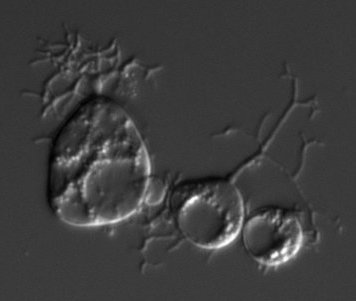
Killer fungus could cause the next amphibian apocalypse
Costa Rica’s now-extinct golden toad. (Photo from U.S. Fish and Wildlife Service)
One amphibian fungus drove 90 species to extinction. Scientists are eyeing a second as it threatens North American salamanders.
A deadly fungus decimated populations of frogs and other amphibians around the globe in the late 20th century. Today a new, even more lethal one is on the march. Biologists are taking lessons from the previous “amphibian apocalypse” to try to hold off the next big wave of deaths and extinctions.
Frogs, salamanders and other amphibians might not stir warm thoughts, but their existence—and their decline—affects humans and other animals in critical ways. The global drop in amphibian populations has drastically affected ecosystems, lowering water quality, harming algae and water insects and destroying food webs critical for the preservation of a range of species.
As a graduate student doing fieldwork in Costa Rica in the 1990s, University of Maryland biologist Karen Lips watched hundreds of golden toads and treefrogs mysteriously drop dead.
The culprit was the fungus Batrachochytrium dendrobatidis, or Bd for short.
“It was like a stake-out waiting for the fungus to arrive,” Lips said during the Council for the Advancement of Science Writing’s New Horizons in Science briefing at the ScienceWriters2019 conference in State College, Pa., Oct. 28. “It was an amphibian apocalypse!”
Bd has caused 90 amphibian species to go extinct, with 501 more in decline. For comparison, the Earth has lost 80 mammal species in the last 500 years. The fungus only affects amphibians but has, in fact, taken a bigger the toll on vertebrate animals than any other invasive species. While antifungal drugs and heat therapy have been explored to treat Bd, treating hundreds of infected amphibians in the wild remains a Sisyphean task.
A small, aquatic fungus that resembles a tadpole, Bd affects all amphibians. It infects frogs’ skin by forming small zoospores that can easily move from one animal to another. Infection severity varies depending on the species of amphibian and the moisture and temperature of the pond where frog and fungus meet.
But Bd’s killer MO is the same for every frog. It lodges in the skin — which is responsible for gas exchange and water absorption—altering its chemistry, disrupting electrolyte balance and eventually causing a heart attack.
Bd originated in East Asia and spread to South America, Southern Africa and Europe and other regions at different times. It is now found in almost every country except isolated island nations such as Papua New Guinea and Seychelles. Tropical zones in Asia and Central America were worst hit, while the U.S. was less affected. The pet trade is likely responsible for introducing Bd to the U.S., given that 4 million amphibians are imported every year and 70 percent of pet stores have infected animals. Globally, Bd now has multiple lineages, suggesting that it can evolve rapidly given suitable hosts.

Six years ago, scientists discovered a new cause for alarm—a species they named Batrachochytrium salamandrivorans, which translates to “fungus that devours salamanders.” Ninety percent of infected animals die within six months.
“This was terrifying,” Lips said. “We’ve seen one amphibian apocalypse, and we don’t want to see another.”
Animals can reduce Bd infection intensity by sloughing off the top layer of their skin to remove zoospores. But infection with this new fungus, called Bsal for short, is harder to shake. That’s because Bsal causes pimple-like skin ulcers that explode to form lesions. The spores can float and persist in water longer than Bd, meaning that they can get attached to insects and ducks and spread quickly to nearby areas. Bsal is thought to suppress animals’ immune systems, preventing the development of a protective response against future infections.
Unlike Bd, which typically thrives in tropical areas, Bsal spreads in temperate zones. It hasn’t yet arrived in the U.S., where 28 percent of all salamander species live—but it’s a matter of time.
In preparation, Lips and her team study communities with multiple salamander species to try to understand how susceptible North American salamander populations will be to this new fungal disease.
They are starting to get answers.
Different salamander species respond differently to Bsal. And salamanders hit by both Bd and Bsal die more quickly than those infected by Bsal alone, which, in turn, die faster than those infected by Bd alone.
Short of disinfecting entire forests and banning hikers, researchers advise that strong government policies and regulations are the best way to prevent Bsal’s spread. There has been some progress on this front. Researchers advocated for and secured an import ban on 201 species of salamanders under the Lacey Act in 2016.
But the larger problem remains.
“We can only list species to be banned, but there is no way to test for specific diseases or pathogens before we import salamanders into the country,” Lips said.
So she has joined forces with other researchers to build a global task force to collect information from affected areas where the fungus pops up.
“There are people out there willing to test dead and dying salamanders if citizens encounter them,” Lips said. Bsal knows no borders, and neither do the conservation efforts of Lips and her colleagues.